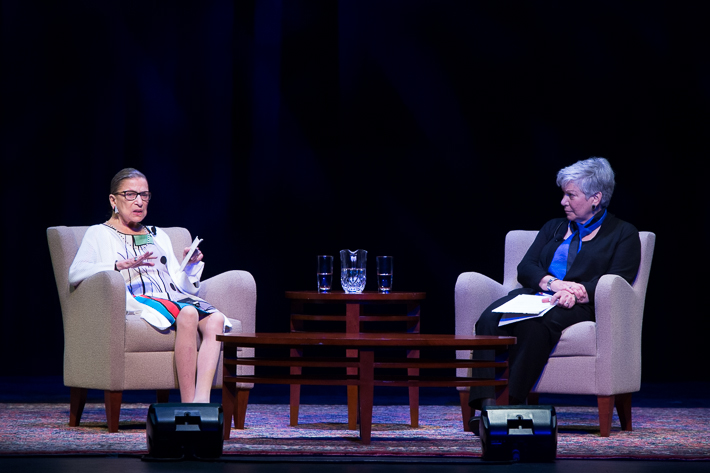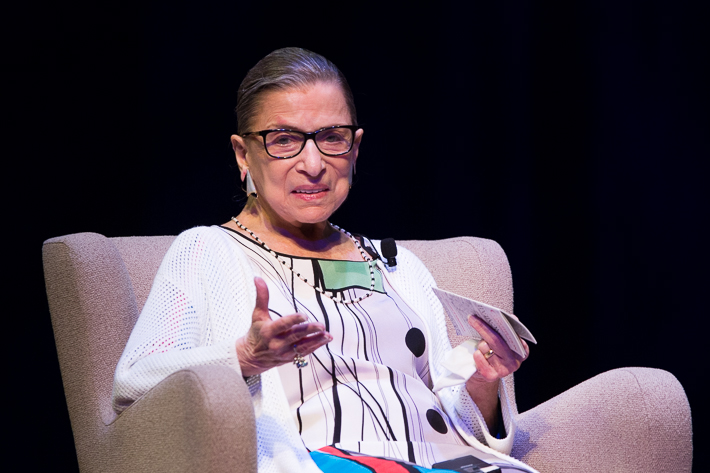At age 81, Ruth Bader Ginsburg is the oldest justice on the Supreme Court. Her exhaustive attention to detail and razor sharp memory have made her a legend on the bench, and it’s these same characteristics that keep her from forgetting the parade of challenges women faced in the first half of the 20th century.
Justice Ginsburg was one of just nine women in a 500-person class at Harvard Law School in the 1950s. Underrepresentation was only part of the struggle. She and her female colleagues had to persevere against the harsh blows of rejection in a field dominated by men.
“Employers were totally upfront about saying, ‘Please don’t send us any women—we don’t want lady lawyers in our shop,’” Justice Ginsburg said.
But Justice Ginsburg was persistent, blazing trails until she became the second woman appointed to the Supreme Court. On Friday, the Constitutional Sources Project (ConSource), The Institute for Constitutional History at the New-York Historical Society and the George Washington University Law School brought her to Lisner Auditorium for the Sixth Annual Capital City Constitution Day celebration to discuss how the 227-year-old document that governs American society has evolved to include women, and the steps still needed to ensure equality in the U.S.
Justice Ginsburg recounted her career as a tenacious litigator and advocate for equal rights in an interview with historian and professor Maeva Marcus. ConSource Executive Director Julie Silverbrook, B.A. ’09, and Law School Associate Dean Christopher Bracey welcomed Justice Ginsburg to GW in opening remarks. Her visit followed Justice Antonin Scalia’s lecture during last year’s Capital City Constitution Day Celebration hosted by ConSource and GW Law.
Earlier in the day, ConSource also held its annual James Madison Legacy Award luncheon to honor former U.S. Attorney General Bill Barr, J.D. ’77, for his belief in and commitment to the U.S. Constitution and civic learning.

Professor and historian Maeva Marcus interviews Supreme Court Justice Ruth Bader Ginsburg about women and the Constitution.
It’s no surprise Justice Ginsburg has dedicated her life to defending rights for women, given how much discrimination pervaded her legal career. She almost secured a clerkship for Justice Felix Frankfurter in 1960, but was denied because of her gender despite a glowing recommendation from Harvard. Justice Ginsburg remembered how Sandra Day O’Connor, the first female Supreme Court justice, similarly touted a stellar academic record from Stanford Law, yet had trouble getting bids from employers.
Fueled by firsthand experience with gender discrimination, Justice Ginsburg helped launch the Women’s Rights Project as part of the American Civil Liberties Union. In her capacity at the ACLU, she wrote a brief for Reed vs. Reed, a landmark equal protection case that forbade discrimination based on gender.
Dr. Marcus remembered a key detail: Although the words in the legendary brief were Justice Ginsburg’s own, she gave authorship credits to Pauli Murray and Dorothy Kenyon, two activists who hadn’t directly contributed to the piece.
The gesture was symbolic, Justice Ginsburg explained. Ms. Murray and Ms. Kenyon were pioneers fighting for women, and they deserved recognition. The move also demonstrated how Justice Ginsburg appreciates being in positions where she has been able to support the ideas of her contemporaries.
“I have been fantastically lucky to be born when I was and to be in the right place to help advance this movement for women’s equality,” she said.
Justice Ginsburg answered several questions from the audience. She revealed that her favorite Constitutional provision is the equal protection under the law section of the 14th Amendment. Her greatest challenges have involved grappling with life and death in capital punishment cases.
She also mentioned this summer’s contentious Burwell v. Hobby Lobby ruling, in which the Supreme Court found employers can object to providing contraception to employees if the action is in conflict with the employer's religious beliefs. Justice Ginsburg made headlines after she wrote a 35-page dissent. She quipped that Congress could fix issues that pertain to the decision, “except sadly, the current Congress doesn’t pass anything.”
Justice Ginsburg believes there is a lot of work left for equal rights for women to be fully realized in the Constitution. She thinks of her granddaughters and wishes they could see a tangible statement of women’s full citizenship written into law, something that could be held up in the same way as freedom of speech and other tenants of American society.
But she does take some comfort in how women are no longer a rare a sight on the Supreme Court. After Justice O’Connor retired in 2006, Justice Ginsburg became the sole woman on the court. It’s a public image that always bothered her—the portrait of a tiny 5-foot female surrounded by eight men in black robes. But almost a decade later, Justice Ginsburg no longer sits alone. She’s flanked by Justices Sonia Sotomayor and Elena Kagan, positioned on either side of the bench like bookends, the three of them enduring icons of women upholding the law.
“Those women are not shrinking violets,” she said of Justice Sotomayor and Justice Kagan. “It looks like we’re there to stay—one third of the court, no longer one-at-a-time curiosities.”

Audience members watch Justice Ginsburg exit Lisner Auditorium after her talk on Friday.


